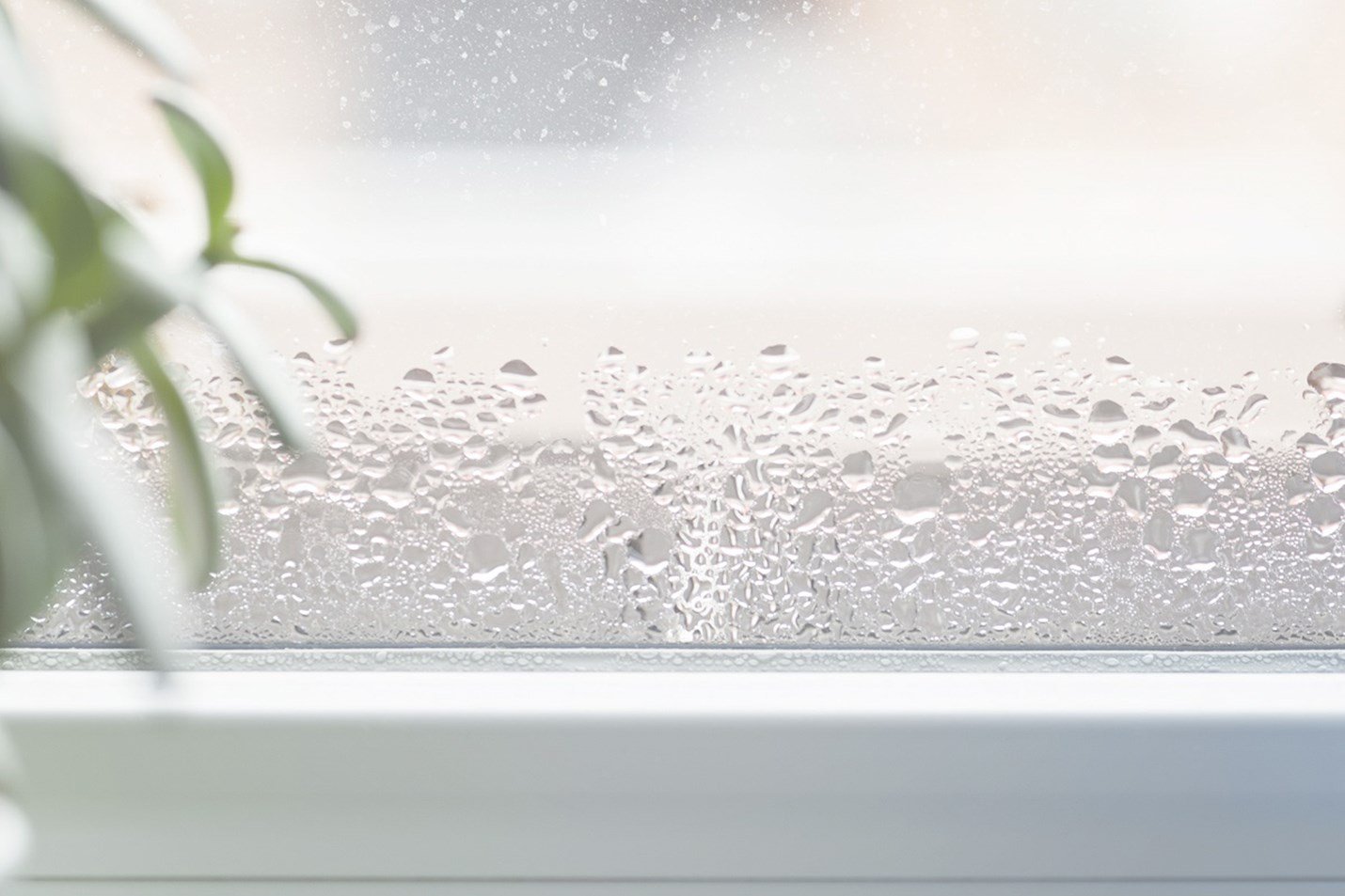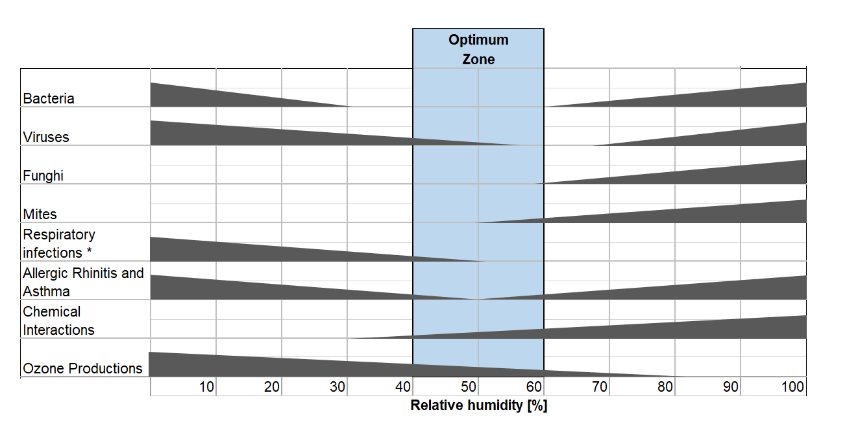Low humidity levels
When it comes to the (HVAC) system in buildings, the main focus may be temperature control, but humidity control is equally, if not more, critical. Air humidity levels affect the people inside — and also the building itself.
Facts about humidity
Humidity plays an important role. For animal life dependent on perspiration (sweating) to regulate internal body temperature, high humidity impairs heat exchange efficiency by reducing the rate of moisture evaporation from skin surfaces. This is also valid for human life.
Humidity is the amount of water vapour in the air.
- Humidity is 'the state or quality of being humid'.
- It is also 'a quantity represents the amount of water vapour in the atmosphere or in a gas'.
- It represents also 'the amount of liquid in the air, in a substance, or on a surface'.
- And in meteorology, humidity is 'a measure of moisture in the air compared with the amount required to saturate it under current conditions'.
Humidity absolute & relative
Air will generally include moisture in the form of water vapour.
- Absolute humidity (AH, expressed as grams or kilograms of water vapour per cubic meter volume of air) is the mass of water vapour in a volume of air divided by the mass of dry air, regardless of the air's temperature.
- Relative humidity (RH, expressed in %) is a measure of the water vapour density of air compared to the water vapour density for saturated air at the same temperature and pressure (that is, the maximum amount of moisture that air can 'hold' at that temperature and pressure).
- Specific humidity (SH, in g/m3 or g/kg) is the ratio of water vapour mass to the total mist air parcel mass, also known as the moisture content.
Humidity, moisture, wetness, mould, dampness, dryness...
The word humidity is a big word, it can have various meanings, and also it can impact & influence various things. It can relate to a weather report; the amount of liquid in the air, in a substance, or on a surface; and levels of humidity in buildings and the conditions for people.
Low or high humidity levels in buildings.
The recommended humidity levels for a healthy and comfortable indoor environment are between 30-60% relative humidity.
When humidity level is too high, it allows dust mites and microbes to grow. The air becomes moist, and mold can start to appear. Unfortunately, people (especially those who have breathing issues and asthma) may develop health issues. High humidity can also make a person feel tired, sluggish, and unable to concentrate.
Low humidity can cause problems. Dry air makes it difficult for some people to breathe, it can irritate the skin, eyes, and sinuses. Low humidity is more common in the winter months because cold air is drier. However, for the regions with cold climate the low humidity can cause problems in other times of the year.
The location and season also come into play. As extreme outdoor air temperatures can affect the inside of the building. And, if the building is located in a coastal area or near a large body of water, one might be dealing with higher levels of humidity.
Ventilation and humidity control is the key.
Good ventilation is key as well as humidity control. One way to efficiently control humidity is proper ventilation, especially in certain areas in all spaces. Because moisture issues commonly occur in areas with poor ventilation, the air has to be constantly and freely circulated throughout the building.

A little water goes a long way.
Humidity affects all – people, animals and plants.
Water vapour is a key agent in both weather and climate, and it is also an important atmospheric greenhouse gas. Humidity affects people’s thermal comfort and the indoor air quality, and it is essential for the indoor environmental quality. Humidity or rather water content is also essential to meeting environmental requirements for machines (vehicles, electronics, aviation), sensitive materials (for example, historic) and technical processes.
What is good humidity?
Optimal humidity in buildings is no longer exclusively a feel-good factor – it can have a direct impact on the health, comfort, well-being and performance.
Importance of proper relative humidity for people’s well-being has been documented for a long time. However, the relative humidity still left a little bit behind. The lack of a signal for relative humidity is particularly surprising given its well-known impact on comfort.

Diagram of relative humidity (% RH) – from low to high (* valid for 80% or more of the occupants in a space).
Can you feel humidity?
There is a physiological effect of humidity that is often neglected: the effect on the feeling of hot or cold. Perspiration/sweating is an essential part of the organism’s thermal control mechanism: the evaporation of sweat removes heat, thus making people cool.
Optimal humidity range for minimising adverse health effects.
The Sterling chart established that both high and low relative humidity levels had a deleterious and costly effect on the health and productivity of the building’s occupants concerning bacteria, viruses, fungi, dust mites, respiratory infections, allergies, asthma, and ozone in the workplaces, at schools and homes.

People can be comfortable in a wide range of humidity depending on the temperature – from 30-70% RH – but ideally between 50-60% RH. Although relative humidity is an important factor for thermal comfort, people are more sensitive to variations in temperature than to changes in relative humidity.
When relative humidity is below 30% RH, the skin becomes dry and symptoms of dry skin include: itching, cracking and chapping. Skin conditions such as psoriasis may become aggravated and worsen at lower relative humidity. Humidity above 30% RH is needed for the mucous membranes in the nose to properly filter the air that people breathe.
Damp air facilitates the growth of fungi (mould) and bacteria that can cause respiratory problems and/or allergic reactions for people. High humidity can make a person feel tired and sluggish.
Watch: Are buildings with low humidity levels really healthy buildings?
Lecturers: Walter Hugentobler, Pawel Wargocki, Timo Schreck & Mikael Börjesson
Webinar recording from Swegon Air Academy, 2023.
In this video, you will learn about interesting facts, research and findings from the perspective of medicine, indoor environmental quality and building systems, including HVAC & ventilation:
- How does humidity affect our health?
- Why is low humidity a problem? What parameters have the greatest impact on the physiology and immunology of our airways?
- How can the HVAC industry, in our various roles as designers, builders, consultants, and architects, impact this area?
Low humidity impacts our bodies, health and well-being
Humidity has a major impact on the human organism, especially the outer (eyes and skin) and inner surfaces (airways and intestine). Because peoples' noses have small dimensions, they are overloaded when absolute humidity is low. Thus, low absolute humidity – especially indoors – reduces the defence of our upper airways due to reduced mucociliary clearance, overcooling, reduced immune defence and dehydration of the mucosa. Our breathing is important, so we must breathe good air in our buildings – and at the right humidity.
Medical perspective on our breathing & health in buildings with low humidity levels.
Compared to the mammalian snout, the human nose has only half the surface area – in relation to body weight - and a volume that is 90% smaller than the snout of a mammal, i.e. they have less surface and volume than any mammal snout.
Our upper airways, eyes and oropharynx (basically the part of our faces with nose, eyes and mouth) had to reduce their size in evolution because of the increasing volume of the brain. The evolutionary trend resulted in the typical flat human face. So, in time, we got smarter but more vulnerable.
And since evolution has decided that more brain capacity brings more benefits to us than high air conditioning capacity - therefore, we should use our brain capacity to support the handicapped air conditioning capacity.
Our airways in our bodies function as the HVAC system in buildings.
Humidity has a major impact on the human organism as a whole, but especially on the outer (eyes and skin) and inner surfaces (airways and intestine).
Human airways do exactly what the HVAC does: air conditioning by heating - cooling – humidification – filtration – heat and moisture recovery. So, the HVAC in buildings turns outside air into indoor air; similarly, the airways in our bodies turn indoor air into alveolar air. (Alveolar gas is a mixture of inspired air, fully saturated with water vapour and carbon dioxide that diffuses from the blood.)
There is a knowledge gap.
The discussion about indoor air is focused on discussions about indoor air quality (IAQ) and indoor environmental quality (IEQ). Many indoor parameters influence air quality, such as temperature, humidity, air velocity, carbon dioxide, radon, light, sound, presence, etc. However, a strong focus is on room/air temperature, carbon dioxide (CO2) and particles (VOCs). Humidity is often neglected.
Research about low relative humidity (dry air) and its effects & perceptions on people.
People do not perceive the air quality with low humidity in any way (no negative or positive effect on people), i.e., people do not sense the low humidity indoors. Concerning physiological responses, people respond to dry air and experience problems with a decrease in mucus flow rate.
Other physiological responses showed that reducing humidity to 5% can change people's inter-blink interval, i.e. people will blink with their eyes more often, and more blinking will also reduce the time people can, for example, look at the screens and work efficiently, going below 15% shows adverse effects on people's cognitive performance. Also, it was observed that relative humidity that is too low (below 30%) or too high (above 60%) has adverse effects on people's stress.
Dry air is unreliable as an indoor air quality perception, and it can be misleading due to the lack of an associated receptor. The perceived dryness may be confused with sensory irritation. Good relative humidity may reduce complaints and favour work performance, for example, in offices. More research is needed to understand how humidity influences people's performance. Low relative humidity aggravates the eye tear film stability and physiology, causing dry eye symptoms.
More research is needed.
We are often missing information – and especially relevant research – on how dry indoor air impacts different population groups: age-related (elderly people versus working adults), health-related (people with allergies and asthma, skin problems) & occupation-related (singers, teachers, theatre and call centres personnel).

How low relative humidity should be allowed in buildings?
Humidity is one of the key elements of indoor climate, but it is often neglected. The optimal relative humidity of the indoor air is between 30-60%. Low humidity in the indoor air in buildings can cause nose & throat irritation, dry mucous membranes & skin, airway infections & cough, hoarseness & wheezing, and influenza symptoms. We can treat humidity as a recyclable asset and the efficient humidity recovery in the ventilation system in buildings can positively impact the indoor environment.
Read our Update&Insight 'Low indoor humidity – from the perspective of indoor environment, research and technology'
Low indoor humidity levels
The optimal relative humidity of the indoor air is between 30-60% (in some regions, about 40-60%). Generally, a relative humidity of 20-70% can be acceptable indoors. Relative humidity < 20% creates uncomfortably dry air.
- Talk more about absolute humidity, not focus only on relative humidity. Absolute humidity is decisive for people’s airways. Every gram and every percent of relative humidity count and 40% of relative humidity or 7-8 g/m3 should be the minimum targeted humidity.
- There is a knowledge gap, and more research with systematic results is needed. Past recommendations about humidity should be revisited. And more information should be provided to the industry and legislation providers. When there is snow outdoors, it will be dry indoors.
- Remarkably simple decisions in the design phase of a building can optimise indoor air humidity, such as installing an efficient solution for humidity recovery as part of the ventilation system in buildings.

You need a good relative humidity
Humidity can have a direct impact on the health, comfort, well-being and performance. The target level of humidity in buildings is typically between 40-60%. Humidity levels also key for building constructions, materials and equipment in buildings. The need of controlling humidity is essential in all buildings such as schools, offices, homes, hospitals, etc.
Drink water (six to eight glasses a day) and keep the relative humidity above 30%.
— Recommendation of the National Institute for Health (NIH)
#humidity
More about humidity
If you are interested in more knowledge related to humidity, here are some interesting reading for you:
Read more from other sources
Evidence shows that humans can suffer from dry air, even though we don't sense it. We feel it in our eyes, skin, mucous membranes, and vocal cords.Pawel Wargocki, Technical University of Denmark